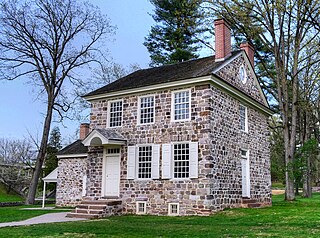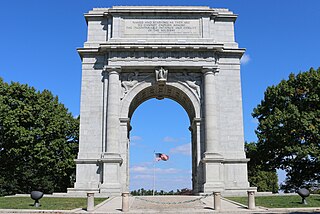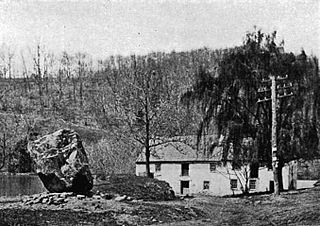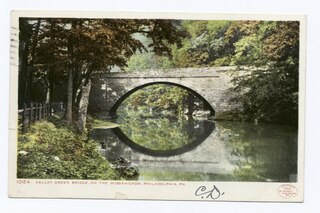| Valley Creek | |
| Creek | |
| Country | United States |
|---|---|
| State | Pennsylvania |
| Region | Chester County |
| Tributaries | |
| - right | Little Valley Creek |
| Mouth | Schuylkill River |
| - location | Valley Forge |
| - elevation | 59 ft (18 m) |
| - coordinates | 40°06′09″N75°27′42.4″W / 40.10250°N 75.461778°W Coordinates: 40°06′09″N75°27′42.4″W / 40.10250°N 75.461778°W |
| Basin | 23.4 sq mi (61 km2) |
| Discharge | for 40°04′45″N75°27′40″W / 40.07917°N 75.46111°W |
| - average | 19 cu ft/s (1 m3/s) |
| - max | 53 cu ft/s (2 m3/s) |
| - min | 9.1 cu ft/s (0 m3/s) |
Valley Creek is a 10.8-mile-long (17.4 km) tributary of the Schuylkill River in eastern Chester County, Pennsylvania, United States, flowing through an area known as the Great Valley. [1]

The Schuylkill River is an important river running northwest to southeast in eastern Pennsylvania, which was improved by navigations into the Schuylkill Canal. Several of its tributaries drain major parts of the center-southern and easternmost Coal Regions in the state.

Chester County (Chesco) is a county in the U.S. state of Pennsylvania. As of the 2010 census, the population was 498,886, increasing by 4.1% to a census-estimated 519,293 residents as of 2017. The county seat is West Chester. Chester County was one of the three original Pennsylvania counties created by William Penn in 1682. It was named for Chester, England.

The United States of America (USA), commonly known as the United States or America, is a country composed of 50 states, a federal district, five major self-governing territories, and various possessions. At 3.8 million square miles, the United States is the world's third or fourth largest country by total area and is slightly smaller than the entire continent of Europe's 3.9 million square miles. With a population of over 327 million people, the U.S. is the third most populous country. The capital is Washington, D.C., and the largest city by population is New York City. Forty-eight states and the capital's federal district are contiguous in North America between Canada and Mexico. The State of Alaska is in the northwest corner of North America, bordered by Canada to the east and across the Bering Strait from Russia to the west. The State of Hawaii is an archipelago in the mid-Pacific Ocean. The U.S. territories are scattered about the Pacific Ocean and the Caribbean Sea, stretching across nine official time zones. The extremely diverse geography, climate, and wildlife of the United States make it one of the world's 17 megadiverse countries.
Contents
Around 1740 a forge was erected along Valley Creek near its confluence with the Schuylkill. This gave rise to the community of Valley Forge. Later the creek powered a saw mill and grist mill there. In 1777, the forge and mills were destroyed by the British Army during the American Revolutionary War. In December 1777, George Washington chose Valley Forge as the site for the winter encampment of the Continental Army partly because Valley Creek and the Schuylkill River formed natural defensive barriers for the rear of the camp. Washington's Headquarters during this period was in a farmhouse close to the confluence. The American forces departed in the spring of 1778.

In geography, a confluence occurs where two or more flowing bodies of water join together to form a single channel. A confluence can occur in several configurations: at the point where a tributary joins a larger river ; or where two streams meet to become the source of a river of a new name ; or where two separated channels of a river rejoin at the downstream end.

The Village of Valley Forge is an unincorporated settlement located on the west side of Valley Forge National Historical Park at the confluence of Valley Creek and the Schuylkill River in Pennsylvania, United States. The remaining village is in Schuylkill Township of Chester County, but once spanned Valley Creek into Montgomery County. The name Valley Forge is often used to refer to anywhere in the general vicinity of the park, and many places actually in King of Prussia, Trooper, Oaks, and other nearby communities will use the name, leading to some ambiguity on the actual location of the modern village.

The British Army is the principal land warfare force of the United Kingdom, a part of British Armed Forces. As of 2018, the British Army comprises just over 81,500 trained regular (full-time) personnel and just over 27,000 trained reserve (part-time) personnel.











